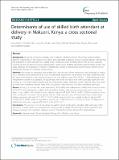Determinants of Use of Skilled Birth Attendant at Delivery in Makueni, Kenya: A Cross Sectional Study
View/
Publication Date
2015-02-03Type
Article, Journalviews
downloads
Metadata
Show full item recordCitation
Gitimu A, Herr C, Oruko H, Karijo E, Gichuki R, Ofware P, Lakati A, Nyagero J. Determinants of use of skilled birth attendant at delivery in Makueni, Kenya: a cross sectional study. BMC Pregnancy Childbirth. 2015 Feb 3;15:9. doi: 10.1186/s12884-015-0442-2. PMID: 25645900; PMCID: PMC4324035.
Abstract/
Background: Kenya has a maternal mortality ratio of 488 per 100,000 live births. Preventing maternal deaths depends significantly on the presence of a skilled birth attendant at delivery. Kenyan national statistics estimate that the proportion of births attended by a skilled health professional have remained below 50% for over a decade; currently at 44%, according to Kenya’s demographic health survey 2008/09 against the national target of 65%. This study examines the association of mother’s characteristics, access to reproductive health services, and the use of skilled birth attendants in Makueni County, Kenya. Methods: We carried out secondary data analysis of a cross sectional cluster survey that was conducted in August 2012. Interviews were conducted with 1,205 eligible female respondents (15-49 years), who had children less than five years (0-59 months) at the time of the study. Data was analysed using SPSS version 17. Multicollinearity of the independent variables was assessed. Chi-square tests were used and results that were statistically significant with p-values, p < 0.25 were further included into the multivariable logistic regression model. Adjusted odds ratio (AOR) and their 95% confidence intervals were (95%) calculated. P value less than 0.05 were considered significant. Results: Among the mothers who were interviewed, 40.3% (489) were delivered by a skilled birth attendant while 59.7% (723) were delivered by unskilled birth attendants. Mothers with tertiary/university education were more likely to use a skilled birth attendant during delivery, adjusted OR 8.657, 95% CI, (1.445- 51.853) compared to those with no education. A woman whose partner had secondary education was 2.9 times more likely to seek skilled delivery, adjusted odds ratio 2.913, 95% CI, (1.337- 6.348). Attending ANC was equally significant, adjusted OR 11.938, 95% CI, (4.086- 34.88). Living within a distance of 1- 5 kilometers from a facility increased the likelihood of skilled birth attendance, adjusted OR 95% CI, 1.594 (1.071- 2.371). Conclusions: The woman’s level of education, her partner’s level of education, attending ANC and living within 5kms from a health facility are associated with being assisted by skilled birth attendants. Health education and behaviour change communication strategies can be enhanced to increase demand for skilled delivery.
Further Details
© 2015 Gitimu et al.; licensee BioMed Central. This is an Open Access article distributed under the terms of the Creative Commons Attribution License (http://creativecommons.org/licenses/by/2.0), which permits unrestricted use, distribution, and reproduction in any medium, provided the original work is properly credited. The Creative Commons Public Domain Dedication waiver (http://creativecommons.org/publicdomain/zero/1.0/) applies to the data made available in this article, unless otherwise stated
Publisher
Springer NatureCollections
- General - GEN [367]

